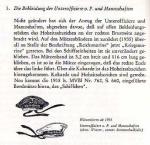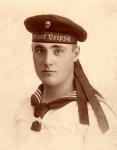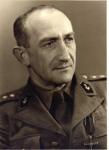-
Posts
2,143 -
Joined
-
Last visited
-
Days Won
10
Everything posted by Odulf
-

Shoulder Boards Commodore 1901-1953
Odulf replied to diwe's topic in Great Britain: Militaria: Badges, Uniforms & Equipment
-
About the Mützenbänder, there is not so much detailed information available as hoped for. In my library I have the next titles, which deal with the subject more or less extensively: - "Unsere Marineuniform - Ihre geschichtliche Entstehung seit den ersten Anfängen und ihre zeitgemässe Weiterentwickelung von 1816 bis 1969", zusammengestellt und bearbeitet von Josef Zienert; Hellmut Gerhard Schutz Verlag, Hamburg, 1970. - "Die Mützenbänder der Kaiserlichen Deutschen Marine 1848-1920", Herausgeber und Verlag Horst Rivier, Kolbermoor, 1980. - "Die Mützenbänder der Deutschen Reichsmarine und der Kriegsmarine des III. Reiches 1920-1945, Herausgeber und Verlag Horst Rivier, Kolbermoor, 1980. - "Headgear of Hitler's Germany - Volume 1: Heer - Luftwaffe - Kriegsmarine", by Jull Halcomb and Wilhelm P.B.R. Saris with Otto Spronk; Published by R.James Bender Publishing, San Jose, Ca., 1989. - "Die Kriegsmarine - Uniforms & traditions - Volume 1", by John R. Angolia and Adolf Schlicht; Published by R.James Bender Publishing, San Jose, Ca., 1991. - "Die Deutsche Wehrmacht - Uniformierung und Ausrüstung 1933-1945 - Band 2, Die Kriegsmarine", Adolf Schlicht / John R. Angolia; Motorbuch Verlag, Stuttgart, 1995. An interesting quote from the first book on the list (Unsere Marineuniform, page 274) I will include below. It states: Auf den Mützenbändern ist zunächst (1935) überall an der Stelle der Beschriftung "Reichsmarine" jetzt "Kriegsmarine"getreten. [On the cap tallies, from 1935 on, any where in place of the text "Reichsmarine" from now on "Kriegsmarine" is worn] In the Imperial Navy, a tally with "KAISERLICHE MARINE" was used (in gold and silver text) by unassigned sailors, and after the Great War (in 1920) this was replaced by a tally "REICHSMARINE" (in gold). Probably a tally "Reichsmarine" in Gothic script followed in 1930, and this, according to Josef Zienert, was replaced by a tally "Kriegsmarine" in 1935. So this could lead to the conclusion that the tally "Kriegsmarine" was in use long before that tally replaced all other tallies in September 1939. To confirm this, I would be interested to see a portrait of a sailor wearing the "Kriegsmarine" tally, dated before September 1939 (preferably with a postmark). I have gone through my collection but without success.
-
I do not agree, because it was Ludendorff who stood side by side to the men who ran up in the Munich revolt, and his name was attached to many revisionist publications after the ending of the Great War. So he sought the lime light thoughtfully in search for personal importance, perhaps even in competition with Hindenburg, and his name was attached to some groups in the "roaring 20s"in Germany. In other words, he did not take a distance from the political situation in which Germany stranded, quite the oposite. And as such, many postcards and signed photos of him appear in dealers lists. He was regarded an icon of the old school, and he let it happen and cherished his role as such.
-
To me a medal bar is a reflection of a career and as such it represents the personal and political implications of a life time. Like picture postcard of a street from a set point views it changes over time. In an era when a past career was an upgrade in society, it is so rare to find medal bars who did not pass the 1935-line (due to the life time of recipients). For replacing earlier medals (by all sorts of societies) by a different arrangement of decorations was far byond the purse of most, in times of crises. In all these respectives, we should not leave the general life circumstances of the people in Germany unregarded. If wishes were horses, then beggars would ride: thus, medal bars assembled pre the introduction of the Hindenburg Cross are scarce. That is why we see very little of these, in fact and on photo.
-
Tallies with the name of the ship/unit in Gothic script (Frakturschrift) were introduced in 1930, and they continued to be worn until 5 September 1939, and again between 1955 and 1960. Here some portraits of sailors of the Reichsmarine, beween 1930 and 1933. Nachrichtenstelle Warnemünde Kreuzer Leipzig Linienschiff Schlesien
-

Polish Cross of Independence.
Odulf replied to leigh kitchen's topic in Central & Eastern European States
I came across this past topic and realised that I have a portrait of an officer wearing this particular decoration. Can any one identify the uniform of this man, please (I presume it is Polish)? -

Deutsches Feld-Ehrenzeichen
Odulf replied to Ladis's topic in Germany: Weimar Republic & Deutsche Freikorps
Thanks JapanX, these insignia are manyfold, but pictures of the badge on a uniform are quite scarce, these were all forbidden and replaced by the Hindenburg Cross. -

Deutsches Feld-Ehrenzeichen
Odulf replied to Ladis's topic in Germany: Weimar Republic & Deutsche Freikorps
An NSDAP official wearing the Feld-Ehrenzeichen, in combination with Verwundeten-Abzeichen and the Tinnie: Gautag Halle-Merseburg 25-02-1935. -

Excellent Reference Book
Odulf replied to Glenn R's topic in Great Britain: Orders, Gallantry, Campaign Medals
A very good "value for money" book indeed, all you wanted to know an many much more is included! One of the best studies I have ever seen on British WW1 medals in the widest sense. -
And only the cap... The cap badge for all RNLN officers is in general the same for all officers of the Sea Branch, embroidered in gold wire, with a wreath of oak leaves, and a woven cap band of silk (or like wise material) in "W" weave. Officers of the Naval Air Service had a 2-bladed propellor, in place of the fowl anchor, Paymasters had the total badge executed in silver, Doctors had the aesculapis in gold, Chemistst had the aesculapis in silver, Engines officers had a torch crossed with 2 arrows. Differences with RN cap badges are: Different crown, no colored velvet in the crown, not a silver anchor, other leaves.
-

Please ID this unit
Odulf replied to TacHel's topic in Great Britain: Militaria: Badges, Uniforms & Equipment
I was wrong in my previous reaction, it is a civil band, The Drum and Showband Adestb Musica from Sassenheim in The Netherlends, their website is http://www.adestmusica.nl/ -

German State Hindenburg Cross question
Odulf replied to tuomaskoivurinne's topic in State, Civil Awards & Decorations
Hi tuomaskoivurinne, I do not consider myself an expert on this subject, but I am keen on German interbellum decorations and stuff. Alas, I have departed from my collection of Hindenburg Crosses, but I have never helt any so poorly executed as your item. Elswhere on this forum, there are most informing posts about the subject, showing examples in collections, but this item is unequalled (to my observation). Dr. Klietmann states, in his standard book "Deutsche Auszeichnungen" (1971), on p.29: As productions' material in advance bronze was adviced, in the meeting of the Reichsministeriums (Departmental Meeting) of the Interior [15-03-1934] a proposal was raised to use steel instead. And thus steel was accepted. In practice iron [alloy] to be painted in bronze was the outcome. Your issue seems to be of zinq, or another alloy, and to be of a much later date. I have found no date, from which the Hindenburg Cross could not be claimed nor issued, thus, it may be a late issue. However; I have no documentation supporting this assumption, and I am worried about the poor finish of your cross, because all Hindenburg Crosses I have held in hand or seen were nicely finished. So, it might have been a release to a "Johny Come Lately", or taken from a scrap basked of discharged medals and "decorated" with a ribbon afterwards. For what is is worth to you, ... -
Hi Martin, I did not have it in my list either, but there have been many more tallies which were not "listed" in books etc. That's the reason why such a study as your's is so valuable. My list contains 440+ different titles, but I think it's not half of all the tallies that were worn, at one time or another, previous to September 1939 (exclusive Marine HJ, Merchant Navy Institutes, and others). Regards, Odulf
-

British Naval Tallys
Odulf replied to Pioneer1's topic in Great Britain: Militaria: Badges, Uniforms & Equipment
Hi Mick, Most of the answers you seek can be found on GMIC, please check out the threads below: http://gmic.co.uk/index.php/topic/49276-info-hms-warspite-sailor-cap/ http://gmic.co.uk/index.php/topic/50851-hms-tallies-how-to-tell-the-difference/?hl=tally HMS was worn by nearly all men dressd as sailors during the war, for reasons of security. HMMTB = H.M. Motor Torpedo Boat (these tallies generally do not carry the number of the MTB). The ship's names on the tallies can be checked via the internet for the period of service and type of ship; many names have been used duting a very long time in various eras. WW2 medals are generally issued unnamed, unless when they are accompanied by a named medal (also bearing a ship's name) it is nearly impossible to work out on what ships he served. For that you will need his Service Record (all men received a copy of this document when they left the Service). Perhaps a copy can be found in the National Archives, but it takes a long time before these are released for research by the public. -
I agree with the observations of Robin. The stamp is a hoax.
-

EK 1914 1914 Combatant Iron Cross awarded to Women
Odulf replied to Naxos's topic in Germany: All Eras: The Iron Cross
According to this information, the Crosses were witdrawn. "Später wurden allerdings diese Verleihungen rückgängig gemacht. Das Eiserne Kreuz sollte den Charakter der Auszeichnung von männlicher Tapferkeit angesichts des Feindes behalten." http://hriesop.beepworld.de/militaer.htm















